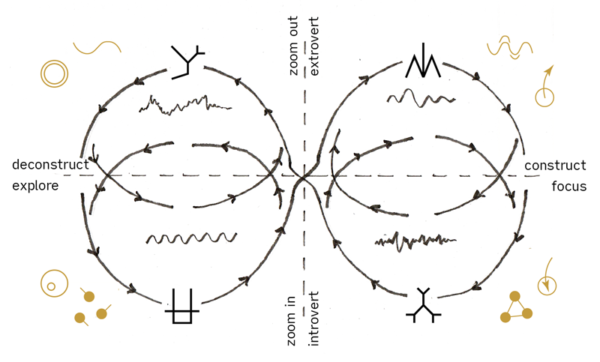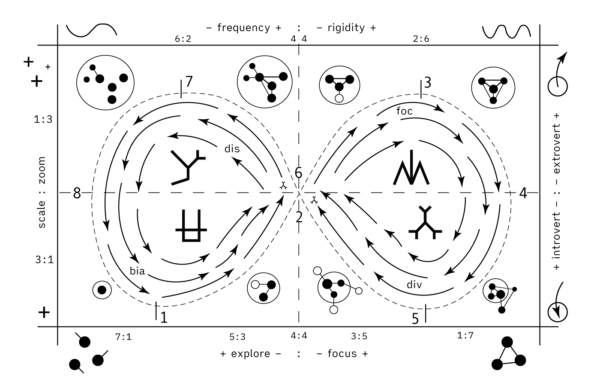In August 2022, I presented the ecological thinking framework in the context of InfraNodus tool for insight generation. InfraNodus platform has thousands of users who use it for ideation, knowledge management, and text analysis. I decided to integrate this framework directly into the tool, so it would be available to the users within their existing workflows. After the functionality was released, I also hosted a webinar where I showcased this methodology and proposed several ways to integrate it into research practice.

The basic approach behind the ecological thinking framework is closely related to panarchy, embracing the iterative nature of any developmental process: a period of extensive growth is followed by stagnation, followed by release, which frees up resources for reorganization. It is a useful framework for thinking about ecological systems, particularly in the context of limited resources. In panarchy, recession and crisis are seen as an opportunity to optimize the existing processes and reorganize them in order to shift to the next evolutionary level. Therefore, we may even be interested to modulate this dynamics and to promote a necessary release of economical tension in order to help the system evolve.

In the frame of this presentation, I applied the same process to thinking, learning, and knowledge management. According to the ecological thinking framework, the developmental cycle of an idea can go through 4 different stages: growth, saturation, optimization, restructurization. The first stage is associated with an exploratory approach gradually becoming more focused on a specific idea, which is gaining connections with a wider conceptual network (zooming out), At a certain point (stage 2), we reach the limits of the current knowledge system and saturation occurs. Every new effort to generate knowledge yields fewer results. Some important marginal improvements can be made at this stage, however, which may set excellence apart from the rest, but the cost of the effort is quite high. It is a state of high focus where connections are made at the big and mid-scale. After a certain period, it is not possible to connect ideas anymore, the existing connections must be broken apart, new ideas must be brought in from outside of the periphery. We enter into the 3rd stage, associated with the notion of release as we don’t hold on to the old ideas anymore. This frees up the space for the new knowledge clusters to emerge, which may seem dispersed because they may lack coherence or be less integrated into the main body of knowledge (stage 4). Finally, new connections are made between those new clusters, forming a coherent entity, which can be developed again (stage 1).
Overall, this process is a succession of zooming in (operating on the conceptual level — small scale) and zooming out (connecting conceptual clusters — big scale), exploring (looking for new ideas and gaps) and focusing (developing the existing ones, making connections between them).
I integrated this framework into InfraNodus interface so that users can benefit from it when exploring their ideas using network thinking. Text network representation makes it possible to use concrete metrics derived from graph theory to estimate the current state of a thinking process. Depending on which stage the ideas are in, the built-in AI will recommend how they can be developed further in order to explore all the different stages available. For instance, if the thinking process is too “stuck” in the growth phase and shows signs of saturation, the system will propose to change the scale of thinking to focus on specific details rather than big ideas. Or to explore ideas at the periphery of the current context. If, on the other hand, the current ideas are too dispersed, the framework will encourage the user to zoom out and to link them together, so that the whole discourse can become more coherent and connected.

